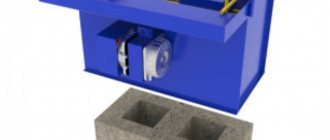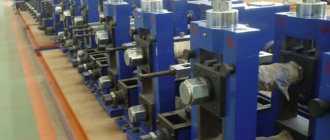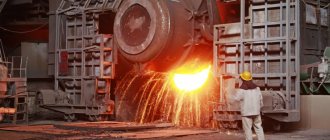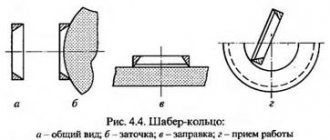Equipment for wire production + video
Wet drawing mills, as a rule, operate using sliding technology and can be combined with dry drawing mills of any multiplicity. They are equipped with independent synchronized electric motors in various modifications.
Also widely used are straight-through dry drawing mills, which are characterized by the most modern design. Such mills are mainly used for the production of small-diameter wire from high-, low-carbon and stainless steel. The main distinguishing features of the mill are its compactness, the absence of belts and pulleys between drives and drums, quiet operation, and the absence of vibrations. Structural design is the main feature of such mills. Thanks to the strength and stability of the frame, the mill can be completely transported, hence the minimum time spent on installation and laying cables.
Direct-flow dry drawing mills are characterized by a horizontal arrangement of drums. Such mills are usually used for the production of wire from low- and high-carbon steels, as well as from stainless steels. The advantages of such equipment are high reliability, ergonomics and ease of operation of the structure, which does not require a special foundation during installation. The unit also features a highly efficient drum cooling system and offers optional equipment.
A variety of wire rod unwinders are also useful for wire production.
Video of how to make wire rod from copper:
Also in the production field, cigar-type twisting machines, double-twisting machines and rope-type machines are widely used.
Delivery and labeling
The finished wire rod is wound into coils weighing at least 160 kg. Typically, each coil is a continuous piece, which is marked according to the requirements of GOST 7566. A marking is attached to each coil, which indicates the manufacturer, wire rod diameter, grade and grade of steel, and heat number. However, it is allowed to wind two sections of wire rod into one coil - but only if one section does not exceed 10% of the mass of the coil. In this case, the manufacturer must guarantee the weldability of the products and put two marking labels - one for each segment.
According to the technical conditions TU 14-15-254-91, wire rod according to TU is manufactured in 4 classes:
class VK - high-quality wire rod;
class VD - wire rod with high deformation;
class KK-quality wire rod;
class PD - structural wire rod.
Properties of aluminum wire
Aluminum is a universal material that has the following characteristics:
- light weight;
- flexibility;
- strength;
- moisture resistance;
- good wear resistance;
- melting point 660 0C;
- resistance to aggressive environments;
- weak magnetic properties;
- biological inertia;
- durability.
Compared to other types of similar products, aluminum wire has many advantages. The material is resistant to corrosion, so it is used where objects come into contact with water. Technical aluminum is easy to process. It has electrical and thermal conductivity. The metal is safe to use as it meets the necessary sanitary and technical requirements.
For the manufacture of profiles, pure aluminum of different grades and its deformable alloys in the form of ingots or wire rods are used. The properties of the product depend on the chemical composition and production method. The diameter of the finished product varies from 0.08 to 10 mm.
Preparation of metal blanks
A wire drawer, using specialized equipment, will only be able to achieve a high-quality final result if the surface of the workpiece is properly prepared. Such preparation consists of removing scale, for which the following methods can be used:
- mechanical;
- chemical;
- electrochemical.
A simpler and more cost-effective method is the mechanical descaling method, which is used for carbon steel workpieces. When performing such cleaning, the workpiece is simply bent in different directions, and then its surface is treated with metal brushes.
Descaler operating technology
More complex and expensive is chemical descaling, which is performed using solutions of hydrochloric or sulfuric acid. A specialist performing such a complex and rather dangerous operation must be well prepared and strictly follow all safety rules for working with aggressive solutions. A chemical cleaning method is indispensable if the wire must be made from blanks made of stainless and other types of high-alloy steels. It should be borne in mind that immediately after chemical cleaning, the surface of the workpiece should be thoroughly rinsed with hot and then cold water.
The electrochemical method of descaling is based on the method of etching in an electrolytic solution. Depending on the implementation features, this method can be anodic or cathodic.
Types and brands of aluminum wire
The production of long aluminum products is regulated by GOST standards. Long aluminum profiles have different classifications based on performance characteristics.
According to the chemical composition of steel:
- low-carbon - with a carbon mass of up to or above 0.25%;
- alloyed;
- highly alloyed;
- based on special alloys.
According to the sectional shape:
- round, oval;
- square, rectangular;
- trapezoidal;
- multifaceted;
- segmental;
- wedge-shaped;
- zeto- and x-shaped;
- periodic, special, shaped profile.
By surface type:
- polished;
- polished;
- etched;
- with metal or non-metallic coating;
- light;
- black.
Every specialist knows the concept of “metal grade”. Decoding the symbols provides information about the chemical composition and physical properties of the material. Alloys are marked with letters and numbers, which determine the composition of chemical elements and their quantity. In accordance with GOST, round wire is designated as follows:
- Solid – AT.
- Semi-solid – APT.
- Soft – AM.
- Increased strength - ATp.
According to GOST 14838-78, products for cold heading are produced based on technical aluminum or its alloys. GOST 7871-75 allows the production of wire for welding. GOST 4784-97 regulates the chemical composition of products. According to GOST 24231-80, tests are carried out to determine the content of metal components.
Transportation and storage
Rules for storing copper wire are regulated by GOST standards. Basic Rules:
- The optimal method of storage and transportation is the use of frame bays. For transportation, the coils must be packed in a special film. It will protect the material from adverse environmental conditions. In most cases, coils can be stored in a fold without packaging.
- The wire must be stored in special warehouses. The basic requirements for storage are low humidity, dry ventilation, minimal risk of prolonged wetting of the material (short-term wetting due to carelessness is allowed), and so on.
- Different grades of copper should be stored separately in the warehouse. If the wire becomes tangled during transportation, untangling is necessary. When unraveling, under no circumstances should the material be allowed to twist in a figure eight pattern.
Wire drawing: technology and equipment - drawing mills and machines
Drawing, by which wire products are produced, is a simple technological operation. Meanwhile, in order to obtain a high-quality product as a result of such a procedure, it must be carried out in the correct sequence and the appropriate equipment must be used for this.
Wire drawing production line
What equipment is used to draw metals?
The equipment that a wire drawer uses in his professional activities is called a mill. A mandatory element of equipping a specialized drawing machine is the “eye” - the die. The diameter of the die, of course, should always be smaller than the cross-sectional dimensions of the workpiece pulled through it.
Ratios of initial and final wire diameters for different types of drawing
Today, manufacturing enterprises use specialized drawing machines of two main types, which differ from each other in the design of the pulling mechanism. So, they distinguish:
- machines in which the finished product is wound on a drum, which provides pulling force;
- equipment with linear movement of finished wire.
Topic: Workplace. Wire production methods.. - presentation
Topic: Workplace. Wire production methods.
Objectives: familiarization with the workplace in a locksmith's workshop; familiarization with the workplace in a locksmith's workshop. What is a bench vice and why are they needed? What is a bench vice and why are they needed? We will cut out what properties the wire has; we will reveal what properties the wire has; and we will learn how to obtain wire. and learn how to obtain wire.
Items made of metal?
What kind of wire is inside a light bulb? Tungsten Tungsten ?
Origin of the locksmith profession. The word “locksmith” comes from the German word “schloss”, which means “lock”. The word “locksmith” comes from the German word “schloss”, which means “lock”. Among Russian masters, the word “schlosser”, to simplify pronunciation, it turned into “shlyusar”. Among Russian masters, the word “schlosser”, to simplify pronunciation, it turned into “shlyusar”. Later, into “locksmith”. Later in the "locksmith".
What is the name of the device used to secure the workpieces? ? Bench vice Bench vice
Practical work Find all the components of the vice that are shown at the vice in the figure. Find all the components of the vice that are shown in the vise in the figure. Fastening the strip metal in a vice so that it protrudes to a height of 10mm above the level of the jaws. Fastening the strip metal in a vice so that it protrudes to a height of 10mm above the level of the jaws. Fastening the strip metal in a vice so that the projection on the side of the vice is 10mm. Fastening the strip metal in a vice so that the projection on the side of the vice is 10mm.
What properties do metals have? electrical conductivity electrical conductivity Thermal conductivity Thermal conductivity Plasticity Plasticity Malleability Malleability Magnetizability Magnetizability metallic color metallic color Hardness Hardness melting point melting point, etc. etc.
What are metals? Metals are substances that have high thermal and electrical conductivity, metallic luster, ductility and other characteristic features. Metals are substances that have high thermal and electrical conductivity, metallic luster, ductility and other characteristic features.
What is wire and what shapes does it come in? Wire is a metal product of long length and relatively small thickness. Wire is a metal product of long length and relatively small thickness. Square Square Round Round Triangular Triangular
What is a semi-finished product? A semi-finished product is a product that is used for the manufacture of other items. A semi-finished product is a product that is used for the manufacture of other items.
A game. "Wire products." Rules: Rules: For 10 minutes, the guys write down objects that are made of wire. For 10 minutes, the guys write down objects that are made of wire. Name wire products one by one, without prompting your neighbor or repeating already named products. Name wire products one by one, without prompting your neighbor or repeating already named products. If a student finds it difficult to answer, he is eliminated from the game. If a student finds it difficult to answer, he is eliminated from the game. The last one standing wins. The last one standing wins.
Rolling is the gradual compression of a metal ingot on a rolling mill between rolls of the appropriate shape. Wire rods with a thickness of more than 5 mm are obtained. represents the gradual compression of a metal ingot on a rolling mill between rolls of the appropriate shape. Wire rods with a thickness of more than 5 mm are obtained.
Rolling.
Drawing is the sequential pulling of rolled wire through a reduction hole (die). sequential pulling of rolled wire through a diminutive hole (die).
Drawing
Practical part Familiarization with wire Consider and determine what kind of wire it is Examine and determine what kind of wire it is What color is the wire What color is the wire Remember where the material you are studying is used Remember where the material you are studying is used Draw a table in a notebook and write down the results of your observations in it . Draw a table in your notebook and write down the results of your observations in it. Type of sample (thin or thick wire) color Properties of the metal (easy to bend, difficult to bend) Scope of application (what can be made from it)
Conclusion So what have we learned today? So what did we learn today? How did the locksmith profession come about? How did the locksmith profession come about? Where did the first wire appear? Where did the first wire appear? And what kind of wire bends the easiest? And what kind of wire bends the easiest?
End of lesson Thanks everyone for your work! Thanks everyone for your work!
Resistance calculation
Electrical resistance is of particular importance in situations where the wire is used as a winding for transformers and generators. After all, if the resistance is too high, then in the event of an emergency, the winding may ignite, which can lead to catastrophic consequences.
Resistance formula
To accurately calculate resistance, use the following formula: R = (P x L)/S. It deciphers like this:
- R is the total resistance. We need to find this parameter as a result of calculations (units of measurement - Ohm).
- P is the resistivity of the material. This indicator is a physical constant, and it depends on the type of chemical element. For copper the constant P will be equal to 0.0175 (units - (Ohm x mm x mm)/m).
- L is the total length in meters. The larger it is, the higher the resistance of the conductor will be.
- S is the cross-sectional area in square millimeters. This parameter also affects the final resistance - the smaller it is, the higher the resistance will be.
Please note that the parameter S is usually indicated in the technical documentation, but instead of the cross-sectional area, sometimes only the cross-sectional diameter of the wire is indicated. In this case, it is necessary to calculate the area using the formula: S = (Pi xdxd)/4. This formula is deciphered as follows:
- Pi is a mathematical constant that is approximately equal to 3.14.
- d is the cross-sectional diameter of the conductor in millimeters.
As a result, the resistance of copper wire is measured using two formulas: R = (P x L)/S = (4 x P x L)/(Pi xdxd).
Examples of problems
Let's try to solve a few simple problems:
- Task 1. Determine the resistance of a wire whose length is 100 meters and cross-sectional area is 5 square millimeters. In our problem, the area parameter is known, so we will use the first formula R = (P x L)/S. Let's substitute our values: R = (0.0175 x 100)/5 = 0.35 Ohm.
- Task 2. Determine the resistance of a wire whose length is 500 meters and cross-sectional diameter is 2 millimeters. In this problem the diameter is known, so we will use the second formula R = (4 x P x L)/(Pi xdxd). Let's substitute our values: R = (4 x 0.0175 x 500)/(3.14 x 2 x 2) = 2.78 Ohm.











